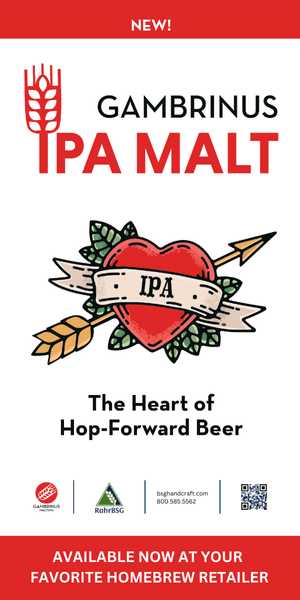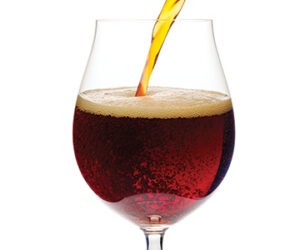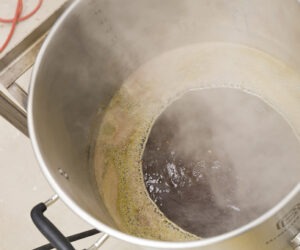Brewing Smoked Beers: Tips from the Pros
The smokiness in smoked beer comes from smoked barley malt. You can purchase smoked malt or make your own in a smoker or on a backyard grill. Examples of smoked beers incude classic German rauchbiers such as Spezial and Schlenkerla as well as American craft brews such as Rogue Smoke and Alaskan Smoked Porter.
Brewer: Dayton Canaday, Alaskan Brewing Company in Juneau, AK
Home homebrewers make beer using Weyermann’s beechwood-smoked malt. Others enthusiastically smoke their own malt using their barbecue grill or an electric smoker. At Alaskan Brewing Company, our preferred method is to use the commercial smokehouse at Taku Smokeries, a local Juneau smokehouse.
One advantage for homebrewers electing to smoke their own malt is a wider range of possibilities for smoking wood. Brewers can smoke with apple, mesquite, pecan, oak, hickory, sassafras, walnut, alder, cherry, almond, maple or even Cabernet grapevine.
We have found that smoke acts as a preservative in beer. The smoke, combined with the yeast left in the bottle, allows the beer’s flavor and aroma to evolve over time.
When smoking, always use chlorine-free water to moisten the grain. Use a cool fire with no glowing coals or flames. Use a fine mesh to protect the malt from ash and tar. Ensure the malt is well-dried for best storage.
You can check the flavor profile of your home-smoked malt by making a “tea” from it. Pour two cups of hot water (140° F) over one cup of smoked malt. Allow this to steep for 10 minutes, then cool the tea to room temperature. Strain the tea and taste it to assess the smoke flavor.
The flavor will be mild in the tea, but more evident in the beer as the aromatics will be enhanced in the finished product due to the carbonation.
Brewer: Lawrence Miller, Otter Creek Brewing, Inc. in Middlebury, VT.
I got intrigued by smoked beer when I got stuck in Bamberg, Germany for a few days. As I drank my first few glasses of rauchbier, I realized there was a terrific connection to the beers of history. Back in the days when all malt was dried in open-fire kilns, the smoke from the local wood would have infused the malt with that element of local flavor.
Choice of wood is the first question you face when formulating a smoked beer. If you want to go for the classic Bamberg flavor, you can purchase Weyermann’s smoked malt and use that right up to 100 percent of the grist for a solid beech character.
For me, though, it is the local character that is wonderful. When I lived in Oregon, I used alder for smoking. When I moved to Vermont, I switched to hickory because that is a much more common smoking wood in New England. I have had good success with mesquite as well.
Smoking techniques are varied, but I like to use a fairly cool smoke. I think it is sweeter. Take a portion of your pale malt — I use 15–25 percent of the total grist depending on the intensity desired — and smoke it as best you can. We lay the malt one-half inch deep on screens, then use a spray bottle to moisten the malt slightly. We put the smoke to the chamber for about four hours at 120° F. At the end, the malt should be dried out and have a nice smoke flavor. The malt will have darkened slightly.
The next decision you face in recipe formulation is choosing a base beer. The classic smoked-beer style is built on a Märzen grist bill, but porter has been a very successful base for many brewers. In particular, Greg Noonan’s Smoked Porter at the Vermont Pub and Brewery in Burlington and Geoff Larson’s Alaskan Smoked Porter are worth a journey.
Hickory Switch is built on a Märzen base, but I have successfully used bock, helles, Vienna lager and other beer styles as a base. The key is to use a recipe that reliably turns out a clean profile. There it is: Have a blast and send me a bottle when you’re done! To argue or ask questions, send an email: [email protected].
Brewer: Jeff Williams, O’Shea Brewing Company in Laguna Niguel, CA
Most people have eaten some type of smoked food, but few have ever tasted a smoked beer. The good thing about smoked beers is that your threshold increases the more you drink it. The first time I drank a glass of Aecht Schlenkerla Rauchbock, I vowed to never drink it again. Years later, I can’t get enough of smoked beers. I put three pounds of rauchmalt in my porter and a quarter pound of peat malt in my Scotch ale. A good homebrewing friend of mine makes a smoked rye that is to die for.
You can buy smoked malt or smoke your own on a smoker or barbecue grill. I use orange wood for smoking.
To do this, I soak the wood in a bucket of water and allow it to dry. Put the wood on hot coals on one side of the grill. Put a pound of base malt on a screen on the other side of the grill (you want to cold-smoke it). Mist the malt with purified water. Close the lid and you’re smoking.
Normally, I smoke my grains for 20 minutes to an hour, depending on the intensity I want.
Once the grains have been smoked, lay the tray in your oven on the lowest temperature with the door open for a few hours to dry the grains. Once dried, put your grains in a Ziploc bag and store them in the freezer for use at a later time.
Home-smoked grains are more intense than commercially produced smoked malt. If you purchase commercially smoked malt, make sure it is fresh. The older the malt, the less smoke flavor and aroma it will contain.
I prefer to mill the pale ale malt prior to smoking. This aids the absorption of the smoke and prevents a messy grain mill. Home-smoked malt is normally high in moisture content. If this smoked grain is milled, the high moisture content will most likely gum up your grain mill.
As for hopping rates in smoked beers, I like to balance out the maltiness and add just a hint more hop bitterness. I believe that bitterness accentuates the smokiness of the beer, so I add a little more hops for flavor and to add depth to the beer.
Smoked Porter
OG = 1.067 (16.4 Plato)
Bitterness = 46 IBUs
Color = 49 SRM
7.0% ABV
- 6 lbs. pale malt extract
- 3 lbs. smoked (rauch) malt
- 0.5 lb. black malt
- 0.5 lb. chocolate malt
- 0.5 lb. roasted barley
- 0.5 lb. crystal malt (80° L)
- 0.5 lb. flaked barley
- 10 AAU Chinook hops (bittering) (0.90 oz. of 10.8% alpha acid)
- 2 AAU Willamette hops (aroma) (0.50 oz. of 4.4% alpha acid) for 5 min
- 1/2 tsp. Irish moss last 15 minutes.
- White Labs WLP001 California Ale Yeast
- 0.75 cup corn sugar (for bottling)
Extract with grains
Steep grains for 30 minutes at 151° F. Combine tea from grain with liquid malts and bring to a boil. At beginning of boil add 0.90 oz of Chinook hops and boil for 60 minutes. Add Irish moss with 15 minutes remaining. At end of boil, add 0.50 oz of Willamette hops, cover and cool. Aerate wort in fermenter and pitch your yeast. Try to ferment at 69 degrees but anywhere between 65-75 is fine. When fermentation is complete, add 0.75 cup of priming sugar and bottle. Condition one to two weeks and enjoy!
All-Grain option
Substitute 8.5 lbs. of your favorite two-row pale malt for the liquid malt extract. Mash grain in three gallons of water at 151° F for 60 mins. Sparge with 168° F water until you have 6.25 gals. in your brew pot. Continue with directions listed above.
Scotch Wee Heavy (with peated malt)
OG = 1.076 (18.4 Plato)
Bitterness = 48 IBUs
Color = 14.5 SRM
7.9% ABV
- 6 lbs pale malt extract
- 3 lbs light dry malt extract
- 0.25 lb. peated malt
- 2 oz roasted barley
- 2 lbs crystal malt (10° L)
- 12.5 AAU Willamette hops (bittering) (2.5 oz. of 5.0% alpha acid)
- 0.5 tsp Irish moss last 15 minutes.
- White Labs WLP028 Edinburgh Ale Yeast
- 0.75 cup corn sugar (for bottling)
Extract with grains
Steep grains for 30 minutes at 151° F degrees. Combine tea from grain with liquid and dry malt extracts and bring to a boil. At beginning of boil add bittering hops and boil for 60 minutes. Add Irish moss with 15 minutes remaining. At end of boil cover and cool. Aerate wort in fermenter and pitch your yeast. Try to ferment at 69° F but anywhere between 65-75° F is fine. When fermentation is complete, add 0.75 cup of priming sugar and bottle. Condition one to two weeks and enjoy!
All-Grain option
Substitute 12 lbs. of Marris Otter pale ale malt for the liquid and dry malt extracts. Mash grain in 4 gallons of water at 151° F for 60 mins. Sparge with 168° F water until you have 6.25 gallons in your brew pot. Continue with directions listed above.



